The Philippine Statistics Authority (PSA) generates statistics for freshwater municipal aquaculture and municipal inland fishing. Production of Quarterly Inland Municipal and Quarterly Aquaculture Surveys are conducted in sample aquaculture farms and sample inland fishing households. The respondents of the surveys are aquafarm operators, fishermen or other knowledgeable members of the household. Generated quarterly fisheries production is included in the quarterly data review process of the PSA at the provincial, regional and national levels. After the data validation, preliminary estimates are made available to data users.
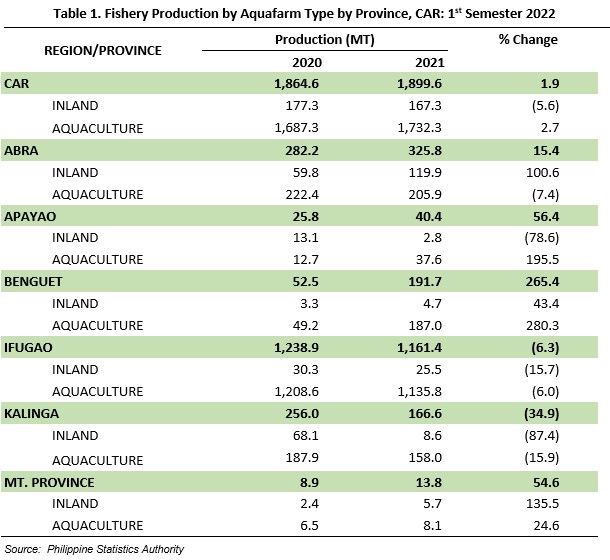
For the 1st semester of 2022, the total fish production of the Cordillera Administrative Region (CAR) increased by 1.9% from 1,864.6 metric tons (MT) in 2021 to 1,899.6 MT in 2022 contributed by aquaculture. The provinces of Abra, Apayao, Benguet, and Mt. Province registered positive trends. However, fish production in the provinces of Ifugao and Kalinga registered negative growths(Table 1).
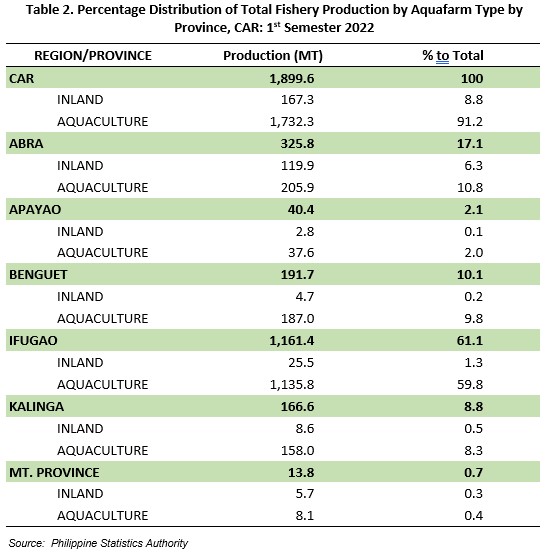
Out of the total regional production of 1,899.6 MT, 1,732.3 MT (91.2%) came from aquaculture and 167.3 MT (8.8%) came from inland fishery production (Table 2).
For the 1st semester of 2022, Ifugao was consistently the top producer with 1,161.4 MT accounting for 61.1% of the total regional fishery production. The province of Abra came second with 17.1% share, followed by Benguet with 10.1%, Kalinga with 8.8%, and Apayao with 2.1% (Figure 1).
Mountain Province contributed the smallest share in the fishery production of the region with an output of 13.8 MT, comprising only 0.7% of the total fish production in the region (Table 2).
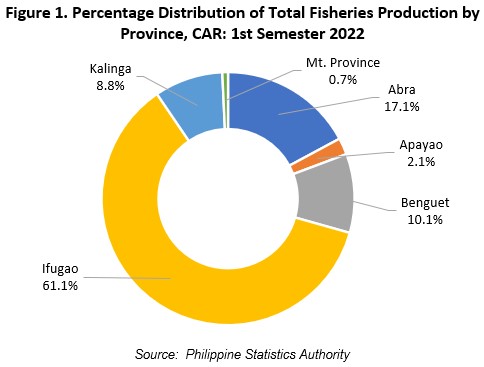
MUNICIPAL INLAND PRODUCTION
Inland municipal fishing refers to fishing in inland waters like lakes, rivers, and dams. Using simple gears and fishing boats, some of which are non-motorized with a capacity of less than three (3) gross tons or fishing not requiring the use of fishing boats.
Cordillera municipal inland fishing output during the 1st semester 2022 was 167.3 MT, comprising 8.8% of the total fishery production in the region (Table 3).
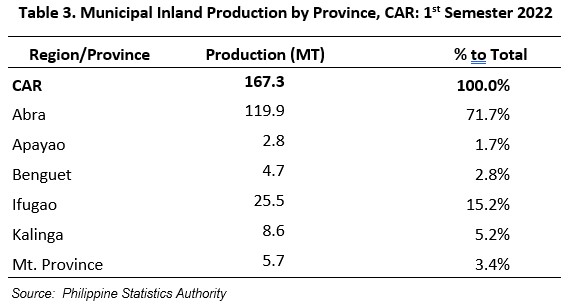
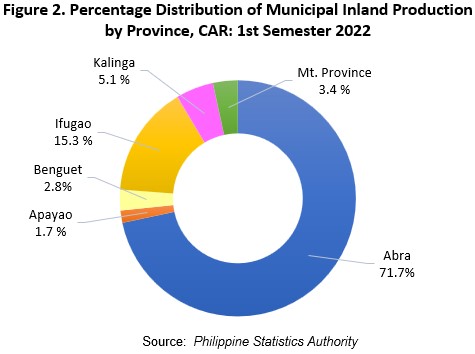
Abra was the top inland fishing province comprising 71.7% of the total inland fishery production of the region. It was followed by Ifugao with 15.3% share. Kalinga came third with 5.1% share, and Mt. Province came fourth with 3.4% share. The provinces with the smallest shares were Benguet and Apayao with 2.8% and 1.7% shares, respectively (Figure 2).
AQUACULTURE PRODUCTION
Aquaculture is a fishery operation involving all forms of raising and culturing of fish and other fishery species in fresh, brackish and marine water areas.
For the 1st semester of 2022, CAR registered an aquaculture production of 535.6 MT with an estimated area harvested of 328.7 hectares. Aquaculture dominated the region’s fisheries accounting for 91.2% of the total fish production (Table 4).
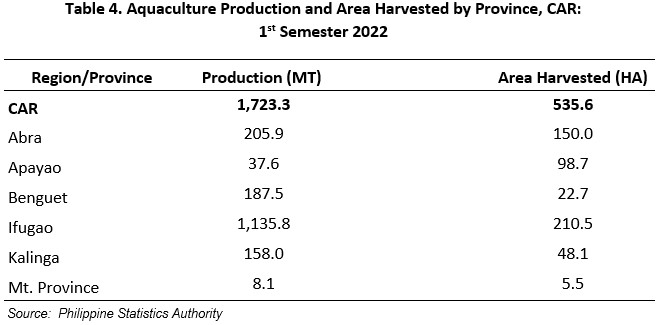
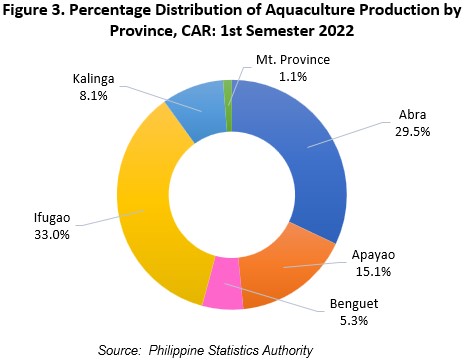
Ifugao province is the aquaculture fishery carrier of the region which posted the highest production with 210.5 MT from an area harvested of 108.3 hectares. Abra came second with 150.0 MT with an area harvested of 96.8 hectares. Mountain Province, on the other hand, had the least production in the region with only 5.5 MT, and an area harvested of 3.7 hectares (Table 4).
In terms of percentage distribution in aquaculture production in the region, Ifugao’s share was 33.0%, followed by Abra with 29.5% share. The shares of the other provinces to total aquaculture production of the region were 15.1% from Apayao, 8.1% from Kalinga, 5.3% from Benguet, 5.3% and 1.1% from Mountain Province (Figure 4).
VILLAFE P. ALIBUYOG
Regional Director
___________________________________________________________________________________________________________________________________
TECHNICAL NOTES
Aquaculture is a fishery operation involving all forms of raising and culturing of fish and other fishery species in fresh, brackish, and marine water areas. The operation is comprised of activities from stocking to harvesting of species under controlled conditions in farming facility called aquafarm.
Aquafarm refers to the farming facilities used in the culture or propagation of aquatic species for purposes of rearing to enhanced production.
Freshwater is water without salt or marine origin.
Aquaculture Production refers to the volume harvested from the aquafarm during the reference period. It includes those species harvested in marketable or matured size and fresh in form.
Fishponds refers to a land-based type of aquafarm; a body of water (artificial or natural) where fish are cultured, raised, or cultivated under controlled conditions.
Fish Cage refers to a stationary or floating fish enclosure made of synthetic net wire/bamboo screen set in the form of inverted mosquito net (“hapa” type) for aquaculture purposes.
Area refers to the size of an aquafarm expressed in hectare. To compute the area: Area = Length x Width.
Area Harvested is the actual area which harvests are realized.
Inland Municipal Fishing is the catching of fish, crustacean, mollusks and other aquatic animal and plants in inland waters like lakes, rivers, dams etc. using simple gears and fishing boats some of which are non-motorized with a capacity of less than three (3) gross tons or fishing not requiring the use of fishing boats.
Inland Municipal Production refers to the volume of catch during the reference period.

